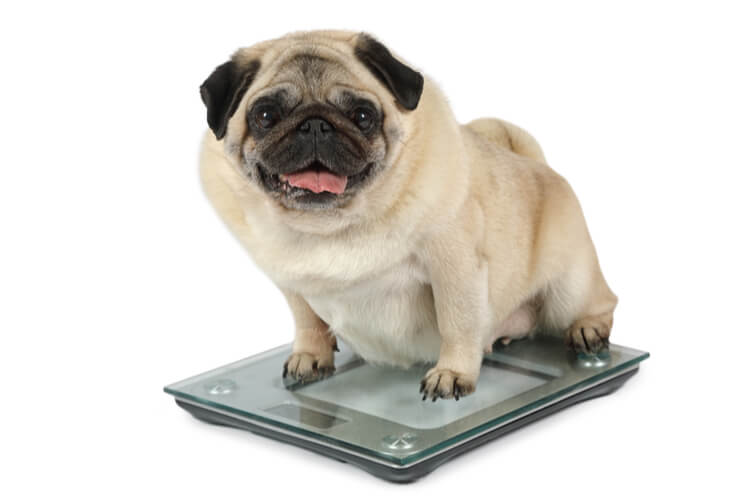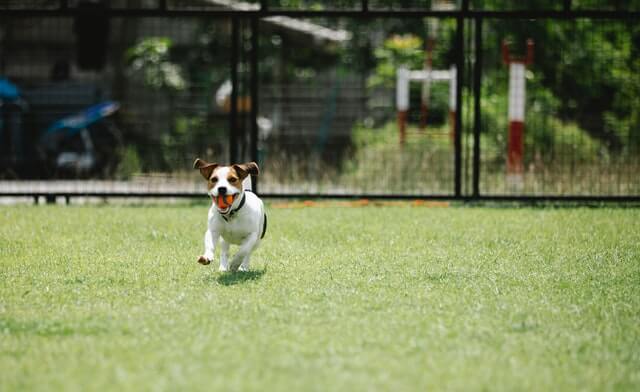The recent pandemic has found many pet owners working from home, spending more time with their pets, and that’s led to many asking “How do I help my dog lose weight?” Being more available to share food or to give a treat has resulted in many dogs gaining quite a bit of weight.1
If you find that your furry friend has gained weight, it is crucial to work to help them lose the excess flub. Weight loss is difficult for pets and people alike but maintaining ideal body weight is essential as it may add years to a dog’s life. Equally important, losing weight may help alleviate many health issues for dogs and make their lives more comfortable and enjoyable!
Helping your dog lose weight can be a challenge, but it can be done with the right approach and dedication. It is important to always consult your dog’s veterinarian before beginning any dog weight loss program.
Tips for Dog Weight Loss
Losing weight isn’t easy – for dogs or humans. Keep in mind that weight loss is a process, and it requires commitment. Your dog will not want to eat less and may beg for food or pester you until you give them something to eat.
There are some helpful tips to keep in mind when trying to get your dog to lose weight:
- Do not feed free choice. Dogs are unable to self-regulate their food intake and will eat out of boredom.
- Always measure the food given with a measuring device. Using a plastic cup or any non-measuring device may cause owners to overfeed without realizing it.
- If your dog begs for food, try not to give in. Redirect their begging into petting or playtime. Take the dog for a walk or play instead of feeding them.
- Feed the dog multiple small meals throughout the day. The total fed in a day should still be the same, but smaller meals lead to satiety and comfort for the dog, knowing they will be fed again soon. This schedule also serves to increase the dog’s metabolism and helps them burn more calories.
- Ensure everyone in the family agrees about the dog’s weight loss. Human food and treats are incredibly calorically dense, and if a family member is giving excess treats, it will sabotage the weight loss plan.
- Try alternative types of treats. Many dogs will eat healthy things such as ice cubes or fresh fruit as treats. Always make sure the treat is not toxic to dogs before offering it, but these substitutions can dramatically reduce the dog’s calorie intake.
Why is weight loss important?
People love to see chubby dogs and often think they are happy and healthy, even if they are very overweight. However, because dogs are much smaller than humans, a few pounds of excess fat can put dogs at risk for developing serious medical conditions.2
Being overweight is the number one risk factor associated with many serious health conditions of dogs. Health conditions that excess weight are associated with include:
- type 2 diabetes
- heart disease
- osteoarthritis (arthritis)
- joint injuries
- high blood pressure
- cancer
Dogs that are overweight have been shown to have shorter lifespans when compared to dogs with healthy weights. The fat dogs also spend less time interacting with their families and are less apt to want to play or go on walks.3
Is my dog ready to lose weight?
As mentioned before, every dog that will be put on a weight loss plan should first have an exam and consultation with its veterinarian. There may be medical reasons that the dog is overweight. Significant weight loss will not be possible until these conditions are controlled, and trying may be dangerous.
What should I feed my dog to get them to lose weight?
Image courtesy of Pexels
Food is the first area to address once a dog has been cleared by its veterinarian for a weight loss program. Weight loss will require fewer calories, and it is essential to feed a diet that will promote weight loss.4
First, your dog’s ideal weight, or goal weight, should be determined. This is a question to ask your veterinarian as there are many variables to consider, including breed, size, and age. Our puppy weight calculator can also help you answer the question “how big will my dog get?” before you start the weight loss journey.
As a veterinarian, I recommend that dogs lose no more than 5% of their body weight per month. Rapid weight loss should be avoided as it may be dangerous for the dog’s health. Many overweight dogs will need a whole year to reach their ideal weight.
Your veterinarian should be asked to calculate the necessary daily caloric intake for your dog. This will give you a way to figure out exactly how much food you should be feeding. If the caloric amount to be fed results in the dog receiving very small amounts of their regular food, it may be helpful to switch to a prescription weight loss diet.
Prescription weight-loss diets are specially formulated to aid in a dog’s weight loss without leaving them hungry. Many of these diets have also been proven to increase the dog’s metabolism and therefore make weight loss easier.
The dog’s food must always be measured, and they should ideally be fed multiple small meals throughout the day.
How do I switch my dog to a new food?
Whether you will be feeding an over-the-counter “light” formula or a prescription weight loss diet, it is important to not switch your dog to the new diet all at once. Before beginning the new food, pet owners should make a plan to mix the dog’s current food with the new diet.
In my practice, I advise owners to feed ¾ of the dog’s current diet mixed with ¼ of the new food for 3-5 days. Then they should mix the two diets 50-50 for another 3-5 days. This should be followed by ¼ of the old diet and ¾ of the new diet for an additional 3-5 days. If the dog does not show any signs of gastrointestinal upset, they then may be fed 100% of the new diet.
Often, “light” or weight loss formulas may not be as appealing to your overweight dog as regular diets. If your dog refuses to eat the new food, don’t give up. Sometimes the dog is holding out for something better, and many owners make the mistake of giving in and feeding a less ideal food (like human food).
I suggest adding warm water, a small amount of low-sodium chicken broth, or a bit of tuna juice to the food. Make sure that the additive soaks into the food, as opposed to top dressing, so the dog is compelled to eat the food and not just the additive.
Does exercise play a role in dog weight loss?
Image courtesy of Pexels
Absolutely! In simple terms, weight loss depends on reducing the number of calories being stored in the dog’s body as fat. This can be accomplished by reducing the calories going in or increasing the number of calories being burned.
Many dogs love going on walks. It is great exercise and also very useful for enriching the dog’s life. If your dog needs to lose weight, increasing the frequency and length of its walks is a great place to start.
The ideal length and pace of walks will vary significantly based on the dog’s size, age, and health status. Incorporating some jogging or playing fetch at the park is wonderful if the dog does not have any health issues such as arthritis or joint instability, making these more aerobic activities unwise.
Other ideas that dog owners can utilize to help their dogs burn more calories include:
- Place the dog’s food upstairs if possible. This will require the dog to burn more calories daily. Use caution in older dogs or dogs with orthopedic issues that make climbing stairs difficult or painful.
- Utilize puzzle feeders. These fun toys come in a variety of shapes and sizes and require the dog to expend energy to obtain their food. They also force the dog to slow their eating, leading to a sense of satiety and fullness with less food.
- Play with your dog. Any movement is helpful and will burn calories. Toys or balls tossed around the house or yard will encourage weight loss and provide entertainment.
How long will my dog have to be on a diet?
The length of time it will take to reduce an overweight dog to their ideal body condition will vary and primarily depends on how overweight they are when they start. Most obese dogs in my practice are put on a weight loss plan that spans a year. A dog should not lose more than 5% of its body weight per month, and most do better losing at a rate of 2-3% a month.
Dogs on a weight loss plan should have frequent checks and weigh-ins with their veterinarian. It is also helpful to document their weight loss journey with pictures, so it is easy to see the progress they are making towards a healthier life. – And keep in mind that the diet may not be temporary – You may just be altering your dog’s routine and foods to promote a healthier life for him or her (make sure you know the foods dogs can and can’t eat).5
Final Thoughts
Weight loss is tough. However, it is worth the commitment and perseverance to enable your dog to live a longer, healthier life.
Weight loss in obese or overweight dogs should not happen quickly but should be a slow and steady process.
Once the dog has maintained their ideal body weight, it is important to continue being vigilant with its diet and exercise so it may maintain its weight loss.
If you have concerns about the weight of a specific breed at a certain age, our growth charts may help you learn more about golden retriever weight, great dane weight, chihuahua weight, goldendoodle weight, or labrador weight.
Article Sources
Pet News Daily uses only high-quality sources, including peer-reviewed studies, to support the facts within our articles. Read our editorial process to learn more about how we fact-check and keep our content accurate, reliable, and trustworthy.
- Gossellin J, Wren JA, Sunderland SJ. Canine obesity: an overview. J Vet Pharmacol Ther. 2007;30 Suppl 1:1-10. doi:10.1111/j.1365-2885.2007.00863.x
- Cortese L, Terrazzano G, Pelagalli A. Leptin and Immunological Profile in Obesity and Its Associated Diseases in Dogs. Int J Mol Sci. 2019;20(10):2392. Published 2019 May 14. doi:10.3390/ijms20102392
- German AJ. The growing problem of obesity in dogs and cats. J Nutr. 2006;136(7 Suppl):1940S-1946S. doi:10.1093/jn/136.7.1940S
- Laflamme DP. Understanding and managing obesity in dogs and cats. Vet Clin North Am Small Anim Pract. 2006;36(6):1283-vii. doi:10.1016/j.cvsm.2006.08.005
- Zoran DL. Obesity in dogs and cats: a metabolic and endocrine disorder. Vet Clin North Am Small Anim Pract. 2010;40(2):221-239. doi:10.1016/j.cvsm.2009.10.009


